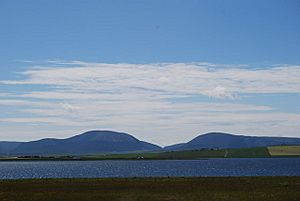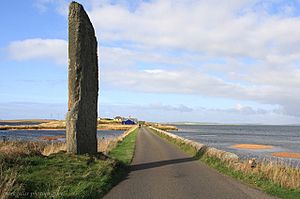Loch of Stenness facts for kids
Quick facts for kids Loch of Stenness |
|
|---|---|
| Stenness loch | |

Looking over the Loch of Stenness towards Hoy
|
|
| Location | Orkney, Scotland |
| Coordinates | 59°00′N 3°15′W / 59.000°N 3.250°W |
| Type | brackish loch |
| Basin countries | Scotland |
| Max. length | 4 mi (6.4 km) |
| Max. width | 1.5 mi (2.4 km) |
| Surface area | 2.5 sq mi (6.5 km2) |
| Average depth | 10.5 ft (3.2 m) |
| Max. depth | 17 ft (5.2 m) |
| Water volume | 716,000,000 cu ft (0.0203 km3) |
| Surface elevation | 3.6 ft (1.1 m) |
The Loch of Stenness is a large loch in Orkney, Scotland. It's called a brackish loch because its water is a mix of fresh water and salty sea water. The loch is on Mainland, Orkney, and gets its name from the nearby area of Stenness.
This loch is about 2 miles (3 km) northeast of the town of Stromness. It sits right next to the Loch of Harray. The Loch of Stenness is also very close to some amazing ancient sites. These include the Stones of Stenness and the Ring of Brodgar, which are part of a World Heritage Site. In the old Norse language, its name was Steinnesvatn.
Water and Its Flow
The Loch of Stenness is a special type of loch that connects to the sea. It is the deepest loch on the Orkney Mainland. Even though it's deep, it's a bit smaller than the Loch of Harray.
This loch is the biggest brackish lagoon in the whole of the UK. A lagoon is a shallow body of water separated from the sea by a narrow strip of land. The water from the Loch of Stenness flows out into the Bay of Ireland and the Hoy Sound. This happens at a place called Brig o’ Waithe. The ocean tides affect the loch here, but they don't change its water level much.
The Loch of Stenness is connected to the Loch of Harray at the Bridge of Brodgar. Together, these two lochs cover a huge area of about 7.5 square miles (19.3 km²). This makes them the ninth largest loch system in Scotland by area. The Loch of Stenness is deepest at about 17 feet (5.2 meters). Its average depth is around 10.5 feet (3.2 meters).
Amazing Wildlife
The Loch of Stenness is very important for its wildlife. This is because its brackish water creates a unique home for many different creatures. It has been given special protection as a Site of Special Scientific Interest and a Special Area of Conservation. These titles mean it's a really important place for nature.
The loch's mix of salt and fresh water supports many kinds of life. You can find animals that live in the sea, in brackish water, and in fresh water here. This includes worms that burrow in the mud. There are also shellfish like mussels and soft-shell clams. A tiny snail called Hydrobia ulvae also lives here. Different types of green algae, known as charophytes, grow in the loch too.
In winter, the Loch of Stenness becomes a vital home for many wildfowl (water birds). These include ducks like pochard, tufted duck, scaup, and goldeneye. They come here to feed and rest during the colder months.
Ancient History Around the Loch
The Loch of Stenness is right next to two very famous ancient sites. These are the Ring of Brodgar and the Stones of Stenness. Both are part of a World Heritage Site, meaning they are important to everyone on Earth.
Near where the Loch of Stenness meets the Loch of Harray, you can see a tall standing stone. This stone is called The Watch Stone. It stands alone and is about 18 feet (5.6 meters) high.
In 2011 and 2012, experts studied the loch and the land around it. They used special tools like geophysical and multibeam sonar surveys. These tools help them see what's hidden underground or underwater. The surveys showed that there might be important ancient structures in the loch. One discovery was a circular shape that could be a henge, similar to the stone circles on land.



